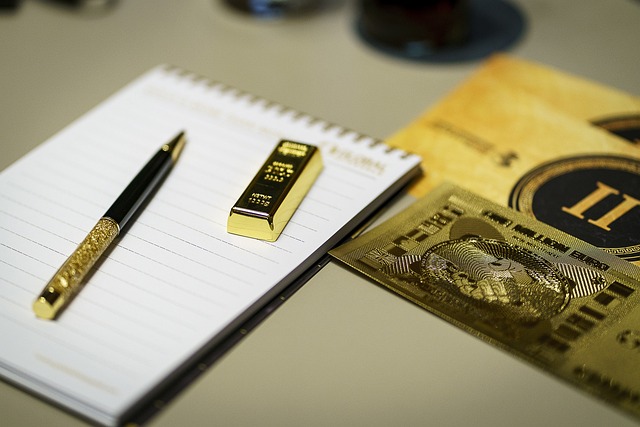Investing in gold through a Roth IRA involves setting up a self-directed account with a custodian experienced in handling precious metals, ensuring compliance with IRS regulations. You must choose from IRS-approved bullion coins and bars, such as American Gold Eagles and Canadian Gold Maple Leafs, and securely store these assets in an IRS-compliant depository. The process includes funding your account through a rollover or cash contribution and maintaining detailed records to preserve the tax benefits of your retirement savings. It's essential to work with professionals who understand the specific rules for Roth IRAs when transitioning from a traditional IRA, and to consult with a financial advisor or tax professional to navigate the tax implications involved in this conversion. Regularly reviewing investment strategies and staying informed on market trends and regulatory changes are key to effectively managing your gold-invested Roth IRA.
Exploring the transformation of a Roth IRA into a gold-backed investment offers a unique avenue for diversification within retirement planning. This article guides readers through the essential steps to establish a self-directed Roth IRA with the capacity to hold physical gold, elevating your portfolio beyond conventional stocks and bonds. As you navigate the rules and regulations of this process, we’ll cover everything from setting up your account to selecting a reputable trustee and custodian, and purchasing eligible precious metals. Additionally, we delve into compliance, tax considerations, and strategies for effectively managing your Roth IRA invested in gold. Embark on this journey to empower your retirement savings with the tangible security of gold.
- Setting Up a Self-Directed Roth IRA for Precious Metals Investment
- Understanding the Rules Governing Roth IRA Conversions to Physical Gold
- Selecting a Trustee and Custodian for Your Gold-Backed Roth IRA
- Purchasing Eligible Gold and Other Precious Metals for Your Roth IRA
- Compliance, Tax Implications, and Managing Your Gold-Invested Roth I
Setting Up a Self-Directed Roth IRA for Precious Metals Investment

To initiate the process of investing in gold through a Roth IRA, one must first set up a self-directed Roth IRA account that permits investments in physical gold and other precious metals. This requires selecting a custodian that specializes in alternative assets, including bullion coins and bars compliant with Internal Revenue Service (IRS) standards. The chosen custodian will guide you through the setup process, which includes completing an application, choosing your investment preference for precious metals, and funding the account—typically with a rollover from an existing IRA or through cash contributions if eligible.
Upon establishing the self-directed Roth IRA, investors gain access to a range of precious metal options. These include gold, silver, platinum, and palladium coins and bars that meet specific fineness requirements as defined by the IRS. Investors must carefully consider the storage and insurance of these assets, as they cannot be held directly in one’s possession. The custodian will provide secure storage solutions or partner with depositories that adhere to IRS regulations, ensuring the integrity and safety of the investment. Throughout this process, it is crucial to remain compliant with all IRS rules regarding Roth IRAs and precious metals to maintain the tax advantages associated with this retirement savings vehicle.
Understanding the Rules Governing Roth IRA Conversions to Physical Gold

When considering the conversion of a Roth IRA to physical gold, it’s crucial to familiarize oneself with the rules and regulations that govern such transactions. The Internal Revenue Service (IRS) sets forth specific guidelines that must be adhered to throughout the process. A self-directed Roth IRA is necessary, as traditional accounts typically restrict investments to paper assets like stocks and bonds. Once you’ve established an eligible self-directed Roth IRA, you can proceed with converting a portion of your IRA balance to gold and other approved precious metals.
The conversion process itself involves transferring funds from your existing Roth IRA to the new self-directed account. After the transfer, you may purchase IRS-approved gold coins or bullion. The approved items include American Gold Eagles, Canadian Gold Maple Leafs, and Austrian Gold Philharmonics, among others. It’s important to ensure that the dealer from whom you purchase the gold is reputable and complies with IRS regulations for the transaction to be valid. Furthermore, the physical gold must be stored in a depository that meets the IRS’s standards for custody of these assets within your Roth IRA. Keeping detailed records of all transactions and maintaining the gold in an approved depository are essential steps to ensure compliance and avoid penalties or taxes on the earnings from your investment. Understanding these rules is vital for a successful conversion of your Roth IRA to physical gold, which can serve as a diversified component of a well-balanced retirement portfolio.
Selecting a Trustee and Custodian for Your Gold-Backed Roth IRA

When converting a traditional IRA to a Roth IRA that is backed by gold, selecting a trustee and custodian who specialize in precious metals is paramount. The trustee administers the IRA and handles the tax aspects, while the custodian safeguards the assets within the account. It’s essential to choose entities with expertise in gold IRAs to ensure compliance with the specific regulations governing such investments. These professionals must be well-versed in the types of gold allowed under IRS guidelines, which typically include American Eagle bullion coins, American Buffalo bullion coins, certain Gold American Eagles, and certain gold bars or ingots that meet fineness requirements.
Once you’ve established a self-directed Roth IRA that permits investments in physical gold, you must select a trustee and custodian who can facilitate the transaction. The chosen custodian will be responsible for the purchase, storage, and appraisal of the gold holdings within the IRA. This requires a custodian with robust security measures and experience in handling precious metals to safeguard your investment. The trustee, on the other hand, oversees the account’s tax-related functions, ensuring that the conversion and subsequent transactions comply with IRS rules. It’s advisable to work with trust companies or financial institutions that have a dedicated department for gold IRAs to ensure smooth management of your Roth IRA investment in precious metals.
Purchasing Eligible Gold and Other Precious Metals for Your Roth IRA

Once you have a self-directed Roth IRA set up that permits the acquisition of physical gold and other precious metals, the next step is to purchase eligible assets that comply with Internal Revenue Service (IRS) guidelines. The IRS stipulates that for a Roth IRA to hold gold or other precious metals, they must be in a form that is approved for retirement accounts. This typically includes gold, silver, platinum, and palladium in the form of bullion or coins that meet certain fineness or purity standards.
To procure these metals, you will engage with a trustee or custodian who specializes in self-directed IRAs and holds the necessary licensing to handle such investments. These custodians partner with reputable dealers who provide IRS-approved precious metals. The purchase process is conducted through the custodian, ensuring that all transactions are compliant with IRS rules. It’s crucial to work closely with your chosen custodian and a precious metals dealer to navigate the selection of eligible assets. They will guide you in making investments that align with your financial goals while adhering to the regulations governing Roth IRAs. This collaboration ensures that your investment in gold and other precious metals is both legally compliant and strategically sound for your retirement savings portfolio.
Compliance, Tax Implications, and Managing Your Gold-Invested Roth I

When considering the conversion of a Roth IRA to gold, it’s crucial to adhere to the regulations set forth by the Internal Revenue Service (IRS). Compliance is paramount; the IRS stipulates that investments within a Roth IRA must be diversified and cannot be held directly in collectibles. To comply with these rules, investors must establish a self-directed Roth IRA with a custodian experienced in alternative assets like precious metals. This custodian will manage transactions and ensure that the gold investments meet the IRS standards for purity and storage.
The tax implications of such a conversion are also significant. Converting to a Roth IRA structure from a traditional IRA may trigger taxes on the amount rolled over, depending on the account holder’s income level at the time of conversion. However, once the funds are in a Roth IRA and invested in gold, the growth of these investments is typically tax-free, as long as certain conditions are met. This tax advantage can be particularly beneficial when the value of gold appreciates over time. It’s important to consult with a financial advisor or tax professional to understand the specific tax consequences related to your situation. Additionally, managing a Roth IRA invested in gold requires careful oversight, including decisions about the type and amount of gold to purchase, as well as the storage and insurance arrangements for the physical gold. The custodian will provide guidelines and assistance in selecting compliant investments and reputable dealers. Regularly reviewing your investment strategy and staying informed about market trends and IRS rules will help you effectively manage your gold-invested Roth IRA.
In conclusion, transitioning a Roth IRA into a gold investment is a process that can be executed with clarity and precision by following the outlined steps. By establishing a self-directed Roth IRA that permits investment in physical gold and other precious metals, investors gain access to a unique asset class outside the conventional stock and bond markets. It’s imperative to understand the rules specific to such conversions, select a trustworthy custodian, and ensure compliance with tax laws throughout this venture. With careful planning and adherence to regulations, investors can diversify their retirement portfolios with gold while leveraging the Roth IRA’s tax advantages.
